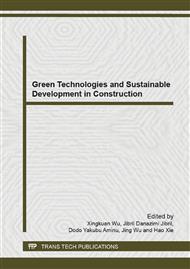[1]
M. K. Al-Emrani, R., Experimental and Numerical Investigation of the Behaviour and Strength of Composite Steel-CFRP member, Advances in Structural Engineering, vol. 9, pp.819-831, (2006).
DOI: 10.1260/136943306779369491
Google Scholar
[2]
Michael V. Seica and J. A. Packer., FRP Materials for the Rehabilitation of Tubular Steel Structures, for Underwater application, Composite Structures, vol. 80, pp.440-450, (2007).
DOI: 10.1016/j.compstruct.2006.05.029
Google Scholar
[3]
Ş. Erdoğdu, et al., Accelerated testing of plain and epoxy-coated reinforcement in simulated seawater and chloride solutions, Cement and Concrete Research, vol. 31, pp.861-867, (2001).
DOI: 10.1016/s0008-8846(01)00487-2
Google Scholar
[4]
Alan D. Zdunek and D. Prine., Early detection of steel rebar corrosion by acoustic emission monitoring, NACE International Annual Conference and Corrosion Show, vol. Paper no. 547, (1995).
Google Scholar
[5]
A. Abbasi and P. J. Hogg, Temperature and environmental effects on glass fibre rebar: modulus, strength and interfacial bond strength with concrete, Composites Part B: Engineering, vol. 36, pp.394-404, (2005).
DOI: 10.1016/j.compositesb.2005.01.006
Google Scholar
[6]
I. Akbar, et al., Derivation of the bond–slip characteristics for FRP plated steel members, Journal of Constructional Steel Research, vol. 66, pp.1047-1056, (2010).
DOI: 10.1016/j.jcsr.2010.03.003
Google Scholar
[7]
F. J. Millero, et al., The composition of Standard Seawater and the definition of the Reference-Composition Salinity Scale, Deep Sea Research Part I: Oceanographic Research Papers, vol. 55, pp.50-72, (2008).
DOI: 10.1016/j.dsr.2007.10.001
Google Scholar
[8]
M. Dawood and S. Rizkalla, Environmental durability of a CFRP system for strengthening steel structures, Construction and Building Materials, vol. 24, pp.1682-1689, (2010).
DOI: 10.1016/j.conbuildmat.2010.02.023
Google Scholar


